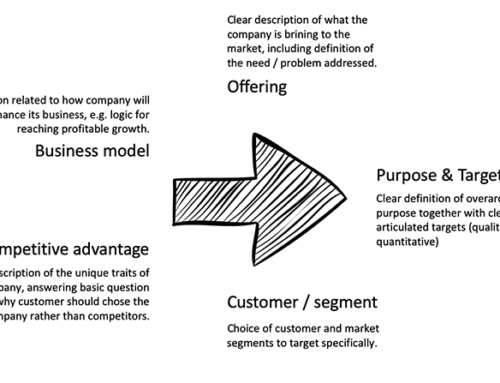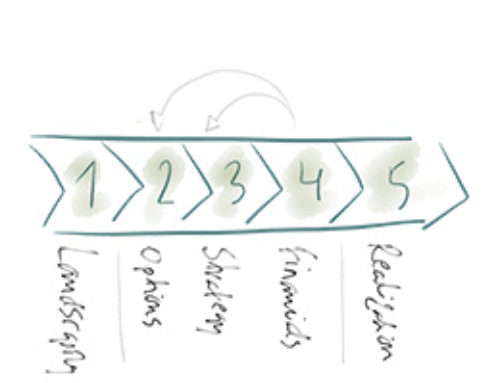Strategy is one of the most ambiguous terms in business today. At 2by2, we believe that strategy is one of the most important and powerful business concepts that you can leverage in order to secure continued profitable growth for your company. One of the key challenges with strategy is to think through the right approach to developing it. In this Insight on Strategy, we share our view of how to best compose the team that will be responsible for developing your strategy.
The four stages of strategy considerations
People who are given the task of developing the corporate strategy for their company typically go through three different stages before actually getting started on the task at hand.
The first thought for these people is often a feeling of pride in having been given such an important task for the company. This typically gives way to pressure soon after, and sometimes anxiety. This marks the beginning of stage 2.
Once they have felt the stress regarding the important task that they have been given, they start thinking about how they actually should go about completing the task; that is, what actions and steps they need to take. Figuring out the process for developing the strategy is stage 3.
At 2by2, we have documented and consolidated all our key learnings from strategy initiatives into one best-practice strategy process that we feel helps people address the specific questions that comes up during stage 3. Even though the process we have described is based on our best practices, we always emphasize that a process for developing a strategy must be tailored to suit the specific needs and situation of any company. Having said this, our best practice process is typically a good starting point.
Having worked out the process that they have in front of them, corporate strategizers typically start thinking about who they should invite to join them in the effort. This is the final stage before starting to develop the strategy. In this Insight on Strategy, we would like to share our perspective regarding what you need to consider when putting together your strategy team.
People matter
No matter how much data you buy, how much you invest in primary research, how well-thought-through your strategy process is, and how well anchored the initiative is in the board and in the executive management team, your strategy efforts can still fail. More often than not, the reason why efforts around strategy development will fail is the people involved. Assembling the right people on an individual basis and forming the right team is absolutely essential for success in your strategy effort.
Key criteria in composing your strategy team
Strategy development is not a democratic process; the key to establishing your strategy team is to dare to be selective and to base your decisions on principles of meritocracy.
There are many aspects to consider when assigning the right individuals to compose the right team for your strategy effort. The following items represent criteria that we believe are relevant.
Business/market competence and expertise
Key selection criteria we recommend should be the competence and experience that the individual can bring to the team and to the process. Ultimately, the only thing that matters is the outcome of the effort; that is, the strategy and how effective it is in creating profitable growth for the company. The most important thing, therefore, is to ensure that you have the right set of people in the strategy development team, individuals who bring a wealth of knowledge and experience for the full business scope. This includes knowledge about the market, customers, competitors, and the company itself; that is, its current position, competitive advantages, product/service portfolio, etc.
Strategy development skills
At least some of the members of your strategy development team should have previous experience working within the functional area of strategy. A strategy development initiative will be a good learning experience for those who have no previous exposure to this area, but the initiative is typically too short to bring them up to a proficient and self-sustained level. These skills include the ability to identify the key questions, structure hypotheses, structure and plan primary and secondary research, document strategy, and communicate and realize strategy.
Personal skills
Based on our experience, there are certain personal skills that are highly valued since they typically have the potential to positively impact the end result. You want to recruit people with high integrity to your team; that is, people who are not afraid to ask questions and have the ability to think independently. You want to have people on the team who like to be challenged and like to challenge other people; for example, when it comes to conclusions from analytical findings. It is essential to ensure that team members have sufficient analytical skills; that is, the ability to conduct both quantitative and qualitative research, identify and conclude analysis with high confidence, and draw conclusions from the analytical findings. Finally, working in a strategy development initiative can be intense, so you need to ensure that the people on your team enjoy working in such a setting and are capable of working independently.
Clarity of roles
 One of the key aspects to consider when putting together your strategy development team is how you split the roles internally in the team once it is established. You need to ensure that there is no ambiguity in terms of roles, responsibilities, and expectations in the team. One person needs to be appointed as the leader; do not try to leverage shared responsibility, as it seldom works well. Furthermore, each individual must have clearly articulated responsibilities; this is typically achieved through modularization of the whole effort. Modularization means breaking down the whole effort into smaller, preferably independent, work modules. For example, a modularized effort might include modules such as market sizing, market trends, future scenarios, competitive landscape, customers and internal module.
One of the key aspects to consider when putting together your strategy development team is how you split the roles internally in the team once it is established. You need to ensure that there is no ambiguity in terms of roles, responsibilities, and expectations in the team. One person needs to be appointed as the leader; do not try to leverage shared responsibility, as it seldom works well. Furthermore, each individual must have clearly articulated responsibilities; this is typically achieved through modularization of the whole effort. Modularization means breaking down the whole effort into smaller, preferably independent, work modules. For example, a modularized effort might include modules such as market sizing, market trends, future scenarios, competitive landscape, customers and internal module.
Allocation of time
A key learning based on the experience from working in strategy development processes is to ensure sufficient allocation of time to the individuals assigned to the team. We recommend having fewer people with a high degree of allocation to the process rather than many people with more limited allocation. Ultimately, an individual assigned to the strategy development team should be allocated 100 percent if possible.
Strategy development is not a democratic process
 One of the most common mistakes when assembling the strategy development team is to mix up strategy development with the actual anchoring process or, in extreme cases, even with realization of the strategy. Strategy development as an activity is completely separated from the anchoring of the strategy in the organization. Anchoring is absolutely essential in order to be able to realize the strategy, but it should not be mixed up with the activity of actually developing the strategy. In the worst case scenario, starting anchoring too early and connecting it too closely to the development effort can lead to the actual strategy simply becoming a compromise based on views and opinions for people being exposed to the strategy through the anchoring process.
One of the most common mistakes when assembling the strategy development team is to mix up strategy development with the actual anchoring process or, in extreme cases, even with realization of the strategy. Strategy development as an activity is completely separated from the anchoring of the strategy in the organization. Anchoring is absolutely essential in order to be able to realize the strategy, but it should not be mixed up with the activity of actually developing the strategy. In the worst case scenario, starting anchoring too early and connecting it too closely to the development effort can lead to the actual strategy simply becoming a compromise based on views and opinions for people being exposed to the strategy through the anchoring process.
Another common mistake when assembling the strategy development team is to reflect the efforts of realization in the team. This typically leads to the strategy development team becoming a reflection of the hierarchy of the company; that is, every function in the company gets a representative in the strategy development team. This seldom works as it typically means that you compromise on the criteria around skills and experience, the team becomes too big, and the process becomes impossible as everyone represents their function rather than thinking about the overarching corporate strategy for the company. Strategy development is not a democratic process; the key to establishing your strategy team is to dare to be selective and to base your decisions on principles of meritocracy.
About Insight on Strategy
Strategy is one of the most overused and misused words in the business community. It is a term that everybody loves to use, but few dare to explain. 2by2 publishes Insights on Strategy to help companies improve their ability to create value through strategy by better understanding what strategy actually is, by learning how to spot the difference between a good strategy and a not-so-good strategy, and by gaining perspectives on the most common pitfalls when developing a strategy.
Previously published articles in this series:
A definition: http://www.2by2.se/insight-on-strategy-a-definition/
Competitive advantage: http://www.2by2.se/insight-on-strategy-competitive-advantage/
Strategy context: http://www.2by2.se/insight-on-strategy-the-strategy-context/
The good strategy: http://www.2by2.se/insight-on-strategy-the-good-strategy/
Strategy pitfalls: http://www.2by2.se/insight-on-strategy-strategy-pitfalls/
The strategy development process: http://www.2by2.se/insight-on-strategy-the-strategy-development-process/





[…] The strategy development team: http://www.2by2.se/insight-on-strategy-the-strategy-development-team/ Competitor benchmarks and customer […]
[…] […]